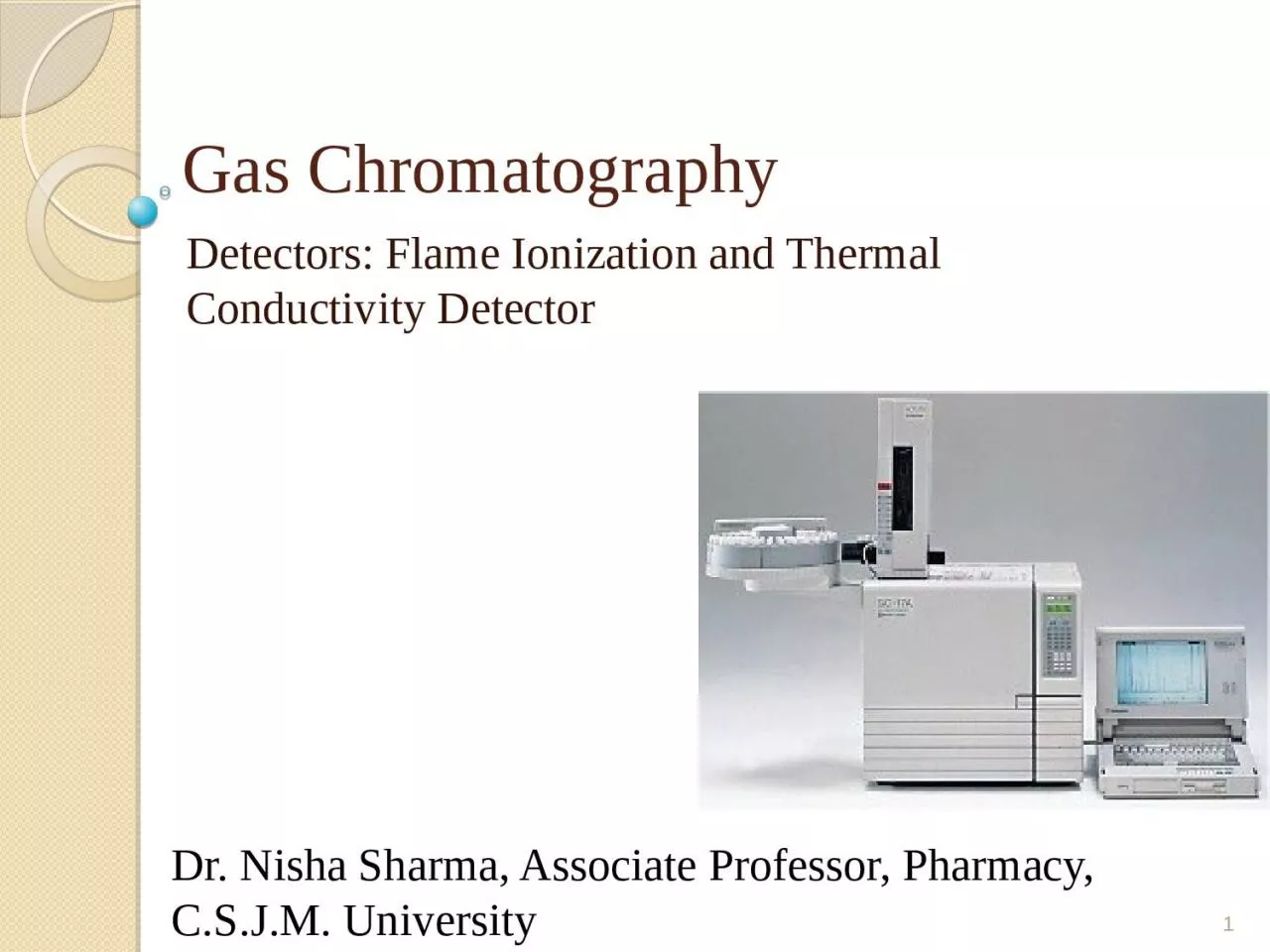

1 Dr Nisha Sharma Associate Professor Pharmacy CSJM University DETECTORS Flame Ionization Detector Nanogram ng Temp of H 2 flame H 2 O 2 N 2 ionizes compds eluted from column into flame ID: 1031146
Download Presentation The PPT/PDF document "Gas Chromatography Detectors: Flame Ioni..." is the property of its rightful owner. Permission is granted to download and print the materials on this web site for personal, non-commercial use only, and to display it on your personal computer provided you do not modify the materials and that you retain all copyright notices contained in the materials. By downloading content from our website, you accept the terms of this agreement.
1. Gas ChromatographyDetectors: Flame Ionization and Thermal Conductivity Detector1Dr. Nisha Sharma, Associate Professor, Pharmacy, C.S.J.M. University
2. DETECTORS Flame Ionization Detector (Nanogram - ng)↑ Temp. of H2 flame (H2+O2+N2) ionizes compds eluted from column into flame. Ions collected on collector electrode and recorded on recorder due to electric current. Potential of 400 V across 2 electrode- lowers the resistance b/w electrodes & causes current to flow.Flame jet & collector position is 0.5-1 cm above the tip of flame. Forms twin electrode 2I=V/R
3. 3
4. Current arises from the ions & free e-, generate in pure H2/air.When ionisable material from column effluent enters flame & burned, current rises abruptly. Current flows thru external resistor, sensed by voltage drop-amplified-sends output device – recorder/ microprocessor.FID –enclosed in chimney-heated sufficiently-to avoid conditions of H2O droplets-from combustion process.FID-responds- no. of –CH2- grps. Introduced into flame.Eg. Response of equimolar amt. of butane is twice to ethane.No responses from fully oxidized C- carbonyl,-COOH gp. Ether grp.Response from C attached to –OH, -NH grp. is ↓If desired CO, CO2--- converted to CH4 by redn. with H over Ni cat.--- Measured 4
5. ExhaustChimneyIgniterHydrogen InletColumn EffluentPolarizing ElectrodeCollector Electrode5Flame Ionization Detector Column effluent is passed through a H2-Air flame – Produces ions and electronsCharged particles are accelerated by voltage applied between jet and collector– results in current Number of ions depends on number of reduced (methylene) carbons in molecule– one molecule of ethane gives twice the signal of one molecule of methane– less sensitive for non-hydrocarbon groups– insensitive to H2O, CO2, SO2 and other noncombustiblesHigh sensitivity, low noise, destructive
6. Thermal Conductivity detector6 A heated filament is cooled by the flow of carrier gas .Metal blockReferencesampleFilamentCarrier gassRLeads to W.S. bridgeCarrier gas outkatharometer
7. Thermal Conductivity Detector7Principle: Electrical power is converted to heat in a resistant filament and the temperature climbs until heat power loss from the filament equals the electrical power input.The filament may loose heat by radiation to a cooler surface and by conduction to the molecules coming into contact with it.The ability of a colliding molecule to carry off heat depends on its thermal conductivity. Hydrogen and helium have high thermal conductivity and therefore will be more efficient at “cooling” a heated filament than other gases will.
8. The detector contains two filaments: one exposed only to carrier gas, while the other is exposed to the carrier gas for sample analysis.When the gas for the sample analysis is only carrier gas , the two filaments can be balanced. Instead of a direct measurement of filament temperature, the filament resistance, which is a function of temperature, is measured.Thermal Conductivity Detector8
9. Thermal Conductivity Detector Measures the changes of thermal conductivity due to the sample (mg). Sample can be recovered. Heated filament is placed on the emerging gas stream. Amount of heat lost from filament by conduction to the detector walls depends on the thermal conductivity of gas phase With in the cavity of metal block- coiled filament- Tunsten metal, Tungsten rhenium alloy, tungsten sheathed with gold. Filament is heated to constant temp. but less than dull red, regulated by DC current Loss from filament to metal block is constant, when only carrier gas flows Thermal conductivity of H & He is 6-10 times greater than organic compounds 9
10. Thermal Conductivity Detector Presence of small amount of organic material results in relatively large decrease in TC of column effluent. Filament retains max. heat & Temp. rises & electrical resistance increases Standard detector: 4 identical filaments, mounted in 1 brass block Filaments form arms of a wheatstone bridge Through one pair of filament column effluent is passed & 2nd pair is places in gas stream near sample injection port Any imbalance b/w pair of filaments are recorded 10
11. Thermal Conductivity Detector When analyte comes, Filament Temp. rises When compound elutes, T.C. of gas mixture of carrier gas & compound gas is decreased Filament in sample column becomes hotter than other control columnResistance increases and imbalance b/w control and sample filament resistance is measuredAbility of colliding molecules to carry off heat depends upon its TC.H & He have high TC & more efficiently cools in heated filament conc. sensing detector11
12. Thermal Conductivity Detector Responds to all compounds, simple construction, Good & Adequate sensitivity to many compounds Good linear range of signal Simple construction Signal quite stable provided carrier gas flow rate, block temperature, and filament power are controlledThe TCD is a nondestructive, concentration sensing detector.12
13. Thermal Conductivity Basics13When the carrier gas is contaminated by sample , the cooling effect of the gas changes. The difference in cooling is used to generate the detector signal. A heated filament is cooled by the flow of carrier gas .FlowFlowMetal blockReferencesampleFilamentCarrier gassRLeads to W.S. bridgeCarrier gas out